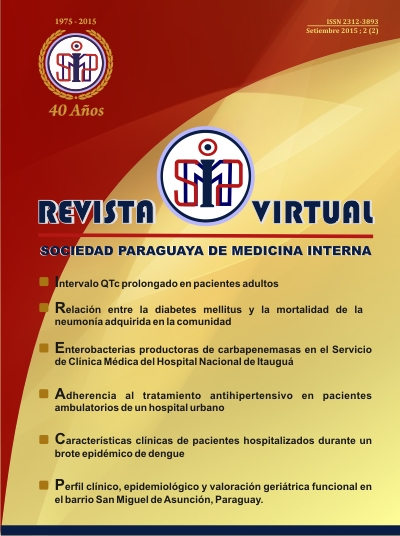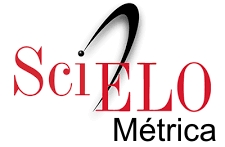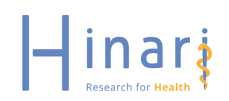Intervalo QTc prolongado en pacientes adultos
Resumen
Introducción: el intervalo QTc prolongado ha sido identificado como factor de riesgo en arritmias ventriculares e incluso muerte súbita.
Objetivo: establecer la prevalencia de QTc prolongado en pacientes internados. Metodología: estudio observacional, descriptivo, prospectivo que incluyó 123 pacientes internados en el Servicio de Clínica Médica y salas de urgencias del Hospital Nacional en 2014. Se consideró como QTc prolongado un valor ≥ 0,44 seg en varones y ≥0,46 seg en mujeres en 4 derivaciones: aVL, DII, V5 y V6. Resultados: la prevalencia de QTc prolongado fue 26%, con predominio del sexo masculino (71%). La principal comorbilidad asociada fue la diabetes mellitus. Los electrolitos K+, Ca+2, Mg+ estaban bajos en la mayoría de estos afectados. El 16% de los pacientes con QTc prolongado terminaron en óbito.
Conclusiones: se halló alta prevalencia de QTc prolongado (26%). Se requieren estudios más complejos para determinar la asociación de esta patología con las comorbilidades, los cuadros neurológicos, el uso de medicamentos y las alteraciones de los electrolitos detectadas.
Citas
Vélez DE. ECG. Madrid: Ed. Marban Libros; 2012
Prutkin JM. ECG tutorial: Basic principles of ECG analysis. UpToDate /Internet/. 2013. /cited 2014 oct 18/. Disponible en: http://www.uptodate.com/contents/ecg-tutorial-basic-principles-of-ecg-analysis
Smith TW, Morgan JP. Excitation-contraction coupling in myocardium. UpToDate /Internet/. 2014. /cited 2015 enero 10/. Disponible en: http://www.uptodate.com/contents/excitation-contraction-coupling-in-myocardium
Funck-Brentano C, Jaillon P. Rate-corrected QT interval: techniques and limitations. Am J Cardiol. 1993 Aug 26; 72(6): 17B-22B.
Seslar SP, Zimetbaum PJ, Berul ChI, Josephson ME. Diagnosis of congenital long QT syndrome. UpToDate /Internet/. 2014. /cited 2015 enero 10/. Disponible en: http://www.uptodate.com/contents/genetics-of-congenital-and-acquired-long-qt-syndrome
Orellana M, Bello F, Escobar E, Adriazola P, Trejo P, González P. Prevalencia del intervalo QT prolongado en diferentes patrones electrocardiográficos. Estudio por teleelectrocardiografía. Rev Chil Cardiol [Internet]. 2009 Dic [citado 2015 Ene 01]; 28(4): 349-56. Disponible en: http://www.scielo.cl/scielo.php?script=sci_arttext&pid=S0718-85602009000300002&lng=es.
Rautaharju PM, Zhang ZM, Prineas R, Heiss G. Assessment of prolonged QT and JT intervals in ventricular conduction defects. Am J Cardiol. 2004 Apr 15; 93(8): 1017-21.
Zayas Molina R, Diaz Garriga RE, Dorantes Sánchez M. Dispersión del intervalo QT: un predictor de arritmias ventriculares malignas. Rev Cubana Cardiol Cir Cardiovasc. 2000; 14(2): 116-23
Jackson H, Huisman LA, Sanatani S, Arbour LT. Long QT syndrome. CMAJ.
Aug 9; 183(11): 1272-5.
Viskin S, Postema PG, Bhuiyan ZA, Rosso R, Kalman JM, Vohra JK, et al. The response of the QT interval to the brief tachycardia provoked by standing: A bedside test for diagnosing long QT syndrome. J Am Coll Cardiol. 2010 May 4; 55(18): 1955-61.
Márquez MF. El síndrome de QT largo: una breve revisión del diagnóstico electrocardiográfico incluyendo la prueba de Viskin. Arch Cardiol Mex. 2012; 82(3): 243-7.
Vicente J, Johannesen L, Galeotti L, Strauss DG. Mechanisms of sex and age differences in ventricular repolarization in humans. Am Heart J. 2014 Nov; 168(5): 749-56.
Medeiros-Domingo A, Iturralde-Torres P, Canizales-Quinteros S, Hernández-Cruz A, Tusié-Luna MT. New perspectives in long QT syndrome. Rev Invest Clin. 2007 Jan-Feb; 59(1): 57-72.
Fanoe S, Hvidt C, Ege P, Jensen GB. Syncope and QT prolongation among patients treated with methadone for heroin dependence in the city of Copenhagen. Heart. 2007 Sep; 93(9): 1051-5.
Zimetbaum PJ, Josephson ME. Genetics of congenital and acquired long QT syndrome. UpToDate /Internet/. 2014. /cited 2015 enero 10/. Disponible en: http://www.uptodate.com/contents/genetics-of-congenital-and-acquired-long-qt-syndrome
Viskin S, Rosovski U, Sands AJ, Chen E, Kistler PM, Kalman JM, et al. Inaccurate electrocardiographic interpretation of long QT: the majority of physicians cannot recognize a long QT when they see one. Heart Rhythm. 2005 Jun; 2(6): 569-74.
LaPointe NM, Al-Khatib SM, Kramer JM, Califf RM. Knowledge deficits related to the QT interval could affect patient safety. Ann Noninvasive Electrocardiol. 2003 Apr; 8(2): 157-60.
Al-Khatib SM, LaPointe NM, Kramer JM, Califf RM. What clinicians should know about the QT interval. JAMA. 2003 Apr 23-30; 289(16): 2120-7.
Roden DM. Clinical practice. Long-QT syndrome. N Engl J Med. 2008 Jan 10; 358(2): 169-76.
Zhang Y, Xiao J, Wang H, Luo X, Wang J, Villeneuve LR, et al. Restoring depressed HERG K+ channel function as a mechanism for insulin treatment of abnormal QT prolongation and associated arrhythmias in diabetic rabbits. Am J Physiol Heart Circ Physiol. 2006 Sep; 291(3): H1446-55.
Rossing P, Breum L, Major-Pedersen A, Sato A, Winding H, Pietersen A, et al. Prolonged QTc interval predicts mortality in patients with Type 1 diabetes mellitus. Diabet Med. 2001 Mar; 18(3): 199-205.
Casis O, Echevarria E. Diabetic cardiomyopathy: Electromechanical cellular alterations. Curr Vasc Pharmacol. 2004 Jul; 2(3): 237-48.
Veglio M, Chinaglia A, Cavallo-Perin P. QT interval, cardiovascular risk factors and risk of death in diabetes. J Endocrinol Invest. 2004 Feb; 27(2): 175-81.
Zardi EM, Abbate A, Zardi DM, Dobrina A, Margiotta D, Van Tassell BW, et al. Cirrhotic cardiomyopathy. J Am Coll Cardiol. 2010 Aug 10; 56(7): 539-49.
Moller S, Henriksen JH. Cardiovascular complications of cirrhosis. Postgrad Med J. 2009 Jan; 85(999): 44-54.
Tornoe CW, Garnett CE, Wang Y, Florian J, Li M, Gobburu JV. Creation of a knowledge management system for QT analyses. J Clin Pharmacol. 2011 Jul; 51(7): 1035-42.
Izurieta C, Curotto-Grasiosi J, Trossero R, Cardús M, Filipini E, Abdala A, et al. QTc interval prolongation and polymorphic ventricular tachycardia related to subarachnoid hemorrhage. Arch Cardiol Mex. 2013 Jan-Mar; 83(1): 40-4.
Goldenberg I, Moss AJ. Long QT syndrome. J Am Coll Cardiol. 2008 Jun 17; 51(24): 2291-300.
Taggart NW, Haglund CM, Tester DJ, Ackerman MJ. Diagnostic miscues in congenital long-QT syndrome. Circulation. 2007 May 22; 115(20): 2613-20.
Zimetbaum PJ, Josephson ME. Pathophysiology of the long QT syndrome. UpToDate /Internet/. 2014. /cited 2015 enero 10/. Disponible en: http://www.uptodate.com/contents/pathophysiology-of-the-long-qt-syndrome
Meyer JS, Mehdirad A, Salem BI, Kulikowska A, Kulikowski P. Sudden arrhythmia death syndrome: importance of the long QT syndrome. Am Fam Physician. 2003 Aug 1; 68(3): 483-8.
Akkerhuis JM, Baars HF, Marcelis CL, Akkerhuis KM, Wilde AA. Congenital long QT-syndrome: the cause of recurrent syncope and sudden death at a young age. Ned Tijdschr Geneeskd. 2007 Oct 27; 151(43): 2357-64.
Saarinen K, Swan H, Kainulainen K, Toivonen L, Viitasalo M, Kontula K. Molecular genetics of the long QT syndrome: two novel mutations of the KVLQT1 gene and phenotypic expression of the mutant gene in a large kindred. Hum Mutat. 1998; 11(2): 158-65.
Witchel HJ, Hancox JC. Familial and acquired long qt syndrome and the cardiac rapid delayed rectifier potassium current. Clin Exp Pharmacol Physiol. 2000 Oct; 27(10): 753-66.
Iturralde-Torres P, Medeiros-Domingo A. Genetic in long QT syndromes. Arch Cardiol Mex. 2009 Dec; 79 Suppl 2: 26-30.
Fosdal I, Wettrell G, Christiansen M, Kanters JK, Larsen LA. Molecular genetics of the long QT syndrome. Genes causing syncope and sudden death. Lakartidningen. 2001 Feb 21; 98(8): 810-5.
Batchvarov V, John Camm A. QT dispersion: Clinical applications. UpToDate /Internet/. 2014. /cited 2015 enero 10/. Disponible en: http://www.uptodate.com/contents/qt-dispersion-clinical-applications
Surawicz B. Will QT dispersion play a role in clinical decision-making? J Cardiovasc Electrophysiol. 1996 Aug; 7(8): 777-84.
Zaidi M, Robert A, Fesler R, Derwael C, Brohet C. Dispersion of ventricular repolarisation: a marker of ventricular arrhythmias in patients with previous myocardial infarction. Heart. 1997 Oct; 78(4): 371-5.
Vloka ME, Steinberg JS. QT Dispersion: Current and Future Clinical Role. J Invasive Cardiol. 1996 Oct; 8(8): 363-9.
Swan H, Viitasalo M, Piippo K, Laitinen P, Kontula K, Toivonen L. Sinus node function and ventricular repolarization during exercise stress test in long QT syndrome patients with KvLQT1 and HERG potassium channel defects. J Am Coll Cardiol. 1999 Sep; 34(3): 823-9.
Schimpf R, Veltmann C, Wolpert C, Borggrefe M. Arrhythmogenic hereditary syndromes: Brugada Syndrome, long QT syndrome, short QT syndrome and CPVT. Minerva Cardioangiol. 2010 Dec; 58(6): 623-36.
Elming H, Sonne J, Lublin HK. Why is QT interval interesting?. Ugeskr Laeger. 2002 Feb 4;164(6):750-4.
Zareba W, Lin DA. Antipsychotic drugs and QT interval prolongation. Psychiatr Q. 2003 Fall; 74(3): 291-306.
Khongphatthanayothin A, Lane J, Thomas D, Yen L, Chang D, Bubolz B. Effects of cisapride on QT interval in children. J Pediatr. 1998 Jul; 133(1): 51-6.
Pratt CM, Ruberg S, Morganroth J, McNutt B, Woodward J, Harris S, et al. Dose-response relation between terfenadine (Seldane) and the QTc interval on the scalar electrocardiogram: distinguishing a drug effect from spontaneous variability. Am Heart J. 1996 Mar; 131(3): 472-80.
Cooke RA, Chambers JB, Singh R, Todd GJ, Smeeton NC, Treasure J, Treasure T. QT interval in anorexia nervosa. Br Heart J. 1994 Jul; 72(1): 69-73.
Di Pasquale G, Pinelli G, Andreoli A, Manini G, Grazi P, Tognetti F. Holter detection of cardiac arrhythmias in intracranial subarachnoid hemorrhage. Am J Cardiol. 1987 Mar 1; 59(6): 596-600.
Palencia R. Neurological complications in patients with heart disease. Rev Neurol. 2002 Aug 1-15; 35(3): 279-85.
Watanabe H, Watanabe T, Sasaki S, Nagai K, Roden DM, Aizawa Y. Close bidirectional relationship between chronic kidney disease and atrial fibrillation: the Niigata preventive medicine study. Am Heart J. 2009 Oct; 158(4): 629-36.
Buemi M, Coppolino G, Bolignano D, Sturiale A, Campo S, Buemi A, et al. Arrhythmias and hemodialysis: Role of potassium and new diagnostic tools. Ren Fail. 2009; 31(1): 75-80.
Alqahtani SA, Fouad TR, Lee SS. Cirrhotic cardiomyopathy. Semin Liver Dis. 2008 Feb; 28(1): 59-69.
Gaskari SA, Honar H, Lee SS. Therapy insight: Cirrhotic cardiomyopathy. Nat Clin Pract Gastroenterol Hepatol. 2006 Jun; 3(6): 329-37.
Adigun AQ, Pinto AG, Flockhart DA, Gorski JC, Li L, Hall SD, Chalasani N. Effect of cirrhosis and liver transplantation on the gender difference in QT interval. Am J Cardiol. 2005 Mar 1; 95(5): 691-4.
Lazzeri C, La Villa G, Laffi G, Vecchiarino S, Gambilonghi F, Gentilini P, Franchi F. Autonomic regulation of heart rate and QT interval in nonalcoholic cirrhosis with ascites. Digestion. 1997; 58(6): 580-6.
Henriksen JH, Moller S, Ring-Larsen H, Christensen NJ. The sympathetic nervous system in liver disease. J Hepatol. 1998 Aug; 29(2): 328-41.
Moaref A, Zamirian M, Yazdani M, Salehi O, Sayadi M, Aghasadeghi K. The Correlation between Echocardiographic Findings and QT Interval in Cirrhotic Patients. Int Cardiovasc Res J. 2014 Apr; 8(2): 39-43.
Yang P, Kanki H, Drolet B, Yang T, Wei J, Viswanathan PC, et al. Allelic variants in long-QT disease genes in patients with drug-associated torsades de pointes. Circulation. 2002 Apr 23; 105(16): 1943-8.
Mount DB. Clinical manifestations and treatment of hypokalemia in adult. UpToDate /Internet/. 2014. /cited 2015 enero 10/. Disponible en: http://www.uptodate.com/contents/clinical-manifestations-and-treatment-of-hypokalemia-in-adults
Hoorntje T, Alders M, van Tintelen P, van der Lip K, Sreeram N, van der Wal A, et al. Homozygous premature truncation of the HERG protein: The human HERG knockout. Circulation. 1999 Sep 21; 100(12): 1264-7.
Piippo K, Laitinen P, Swan H, Toivonen L, Viitasalo M, Pasternack M, et al. Homozygosity for a HERG potassium channel mutation causes a severe form of long QT syndrome: Identification of an apparent founder mutation in the Finns. J Am Coll Cardiol. 2000 Jun; 35(7): 1919-25.
Lupoglazoff JM, Cheav T, Baroudi G, Berthet M, Denjoy I, Cauchemez B, et al. Homozygous SCN5A mutation in long-QT syndrome with functional two-to-one atrioventricular block. Circ Res. 2001 Jul 20; 89(2): E16-21.
Splawski I, Timothy KW, Sharpe LM, Decher N, Kumar P, Bloise R, et al. Ca(V)1.2 calcium channel dysfunction causes a multisystem disorder including arrhythmia and autism. Cell. 2004 Oct 1; 119(1): 19-31.
Locati EH, Zareba W, Moss AJ, Schwartz PJ, Vincent GM, Lehmann MH, et al. Age- and sex-related differences in clinical manifestations in patients with congenital long-QT syndrome: findings from the International LQTS Registry. Circulation. 1998 Jun 9; 97(22): 2237-44.
Kannel WB, Wilson PW, D'Agostino RB, Cobb J. Sudden coronary death in women. Am Heart J. 1998 Aug; 136(2): 205-12.
Link MS, Pelliccia A. Electrocardiographic abnormalities and conduction disturbances in athletes. UpToDate /Internet/. 2014. /cited 2015 enero 10/. Disponible en: http://www.uptodate.com/contents/electrocardiographic-abnormalities-and-conduction-disturbances-in-athletes
Zhou SH, Wong S, Rautaharju PM, Karnik N, Calhoun HP. Should the JT rather than the QT interval be used to detect prolongation of ventricular repolarization? : An assessment in normal conduction and in ventricular conduction defects. J Electrocardiol. 1992; 25 Suppl: 131-6.
Michishita R, Fukae C, Mihara R, Ikenaga M, Morimura K, Takeda N, et al. Association between the physical activity and heart rate corrected-QT interval in older adults. Geriatr Gerontol Int. 2015; 15(7):895-901.
Carrillo-Esper R, Antigua-Bretón YY, Carrillo-Córdova JR. Alteraciones electrocardiográficas en hemorragia subaracnoidea por ruptura de aneurisma: Reporte de un caso y revisión de la literature. Rev Mex Anest 2007; 30(2): 122-6.
Takenaka I, Aoyama K, Iwagaki T, Ishimura H, Kadoya T. Development of torsade de pointes caused by exacerbation of QT prolongation during clipping of cerebral artery aneurysm in a patient with subarachnoid haemorrhage. Br J Anaesth. 2006 Oct; 97(4): 533-5.
Carrillo-Esper R, Limón-Camacho L, Vallejo-Mora HL, Contreras-Domínguez V, Hernández-Aguilar C, Carvajal-Ramos R, Salmerón-Nájera P. Non-hypothermic J wave in subarachnoid hemorrhage. Cir Cir. 2004 Mar-Apr;72(2):125-9.
Podrid PJ. Major side effects of beta blockers. UpToDate /Internet/. 2014. /cited 2015 enero 10/. Disponible en: http://www.uptodate.com/contents/major-side-effects-of-beta-blockers
Pang L, Koren G, Wang Z, Nattel S. Tissue-specific expression of two human Ca(v)1.2 isoforms under the control of distinct 5' flanking regulatory elements. FEBS Lett. 2003 Jul 10; 546(2-3): 349-54.

















